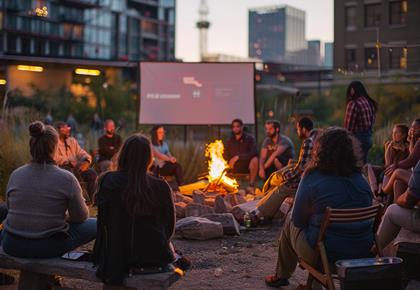Summary
The start-ups in the previous list succeeded not just because they had a good product, but because they found innovative and genuine ways to share their story with the world.The key to a successful marketing campaign is understanding your audience deeply and figuring out how to speak their language, meet their needs, and exceed their expectations.
Why Do Start-ups Need Marketing?
When you’re just starting out, you’re the new kid on the block in the biggest, busiest neighbourhood you can imagine. Nobody knows who you are, what you do, or why they should even pay attention to you.That’s where marketing comes into play. It’s about making the right kind of noise that turns heads, sparks curiosity, and gets people talking.
Great marketing doesn’t just tell people you exist; it shows them why they should care.
No Marketing Means No Start-up
Imagine you’ve built the most fantastic, life-changing product. Now, picture it gathering dust because no one knows it exists. That’s the harsh reality for start-ups that skip on marketing.According to research by economics professors, including Peter Drucker, a leading figure in the study of management, “The aim of marketing is to know and understand the customer so well the product or service fits him and sells itself.”
In simpler terms, even the most revolutionary products need a voice to tell their story, or they risk fading into obscurity.
If you skip marketing, your start-up will slowly be heading towards failure. Today’s market is super busy and crowded, so being seen is just as important as having a great idea.
10 Successful Marketing Campaigns Explained
Dollar Shave Club’s Launch Video
The Campaign: A humorous launch video that introduced a subscription-based razor service.
Why It Worked?
The video was straightforward, funny, and relatable, breaking the ice in a market dominated by giants. It made the brand instantly memorable.
Lesson for Start-ups:
Don’t be afraid to infuse humour and personality into your marketing. A creative video that tells your story can be a powerful way to connect with your audience.Airbnb’s “Live There” Campaign
The Campaign: Encouraging travellers to not just visit, but live like a local in the places they visit, using Airbnb.
Why It Worked?
It tapped into the growing desire for authentic travel experiences, different from the cookie-cutter tourist trips.
Lesson for Start-ups:
Highlight how your product or service can offer a unique, enriching experience that competitors don’t.Slack’s Customer Success Stories
The Campaign: Sharing real success stories of teams that improved their productivity by using Slack.
Why It Worked?
It provided tangible evidence of the value Slack offers, directly from the users themselves.
Lesson for Start-ups:
Use customer testimonials and success stories to showcase the real-world value of your product.Dropbox’s Referral Program
The Campaign: Offering extra storage space for every friend that users referred to Dropbox.
Why It Worked?
It used existing users to gain new ones, effectively turning its user base into a marketing team.
Lesson for Start-ups:
Use incentives to encourage your current customers to spread the word about your product.Warby Parker’s Home Try-On
The Campaign: A program that lets customers try on five pairs of glasses at home for free.
Why It Worked?
It eliminated the risk of buying glasses online, making the purchase decision easier for customers.
Lesson for Start-ups:
Find ways to reduce the perceived risk for your customers. A free trial or demo can make all the difference.Spotify’s Year in Review
The Campaign: An annual personalized summary of users’ listening habits over the year.
Why It Worked?
It was highly shareable content that drew on personal identity and nostalgia, creating a buzz on social media.
Lesson for Start-ups:
Personalization can make your marketing campaigns more engaging and shareable.Robinhood’s Waiting List
The Campaign: A waiting list for early access to the app, where referring friends moved you up in the queue.
Why It Worked?
It created a sense of exclusivity and urgency to join, with a built-in mechanism for viral growth.
Lesson for Start-ups:
Gamify the access to your product or service to spark interest and encourage sharing.Casper’s Sleep Channel
-
The Campaign: A quirky, branded playlist of sounds and stories to help people fall asleep.
Why It Worked?
It was a unique way to engage with their audience beyond just selling mattresses, providing additional value.
Lesson for Start-ups:
Think about what complementary services or content you can offer to add value to your customers’ lives. Glossier’s Social Media Engagement
The Campaign: Building a brand heavily on customer input and interaction on social media.
Why It Worked?
It created a community around the brand, making customers feel like they were part of the development process.
Lesson for Start-ups:
Actively engage with your customers on social media. Their feedback can be gold, and their advocacy can spread the word far and wide.Tinder’s College Ambassador Program
The Campaign: Hiring college students as brand ambassadors to promote the app on campus.
Why It Worked?
It targeted the ideal user base directly in their environment, making the app go viral among college students.
Lesson for Start-ups:
Consider grassroots approaches and how you can turn your target audience into ambassadors.
Leave a comment
Leave a comment, an idea, a related blog post on X (Twitter)X (Twitter)

Most GTM strategies fail because they’re generic and boring. The secret to a killer go-to-market strategy? Pick an enemy. Rally your audience against inefficiency, high prices, or boring competitors. Build a brand that fights for something.

Growing a business in a niche market is a different game. Partnerships, focus, and authenticity are key. Here’s how to do it right

Technology or human touch? Many startups lose their magic with customers as they grow.Learn the secrets to scaling without losing their loyalty.
![Top 10 Client Objections and How to Handle Them [2024 Edition]](/images/blog/top-10-client-objections-and-how-to-handle-them.jpg)
Facing client objections can be frustrating, but they are a natural part of any business interaction. Instead of seeing them as roadblocks, view them as opportunities to better understand your clients and improve your approach.

Ever wondered how a story can turn an unknown gadget into a must-have? 🤔 Discover the art of storytelling in marketing unconventional products!

Absolutely vital for any business looking to get better: Closing the customer feedback loop. 🎯 Discover the 7 key steps top companies like Apple, Amazon, and Google use to effectively harness customer insights!

